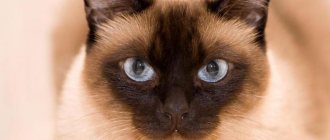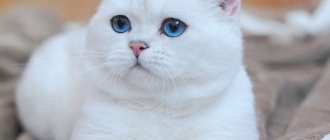People who do not particularly understand cat breeds call such cats Siamese, although, on the other hand, this breed has gained worldwide recognition among felinologists quite recently. In addition, there are some similarities between these breeds, but despite this, Thai cats are an example of how optimal the proportions of animal body parts can be. In fact, this is not the main reason that animals of this breed are very popular.
Along with a harmonious exterior, this cat combines playfulness, as well as nobility, high sophistication, as well as spontaneity, tenderness, affection for humans, and the hunting instinct.
Origin of the breed
The homeland of Thai cats, as the name suggests, is the kingdom of Thailand. The most ancient images of these animals appeared in the 14th century. They are considered the ancestors of modern Siamese, which were called old-type. The distinction between these breeds was achieved through long selective breeding work. Old-type individuals arrived on the European continent in the 19th century, and in the USA at the beginning of the 20th. Breeders received cats that only vaguely resemble their ancestors. Standards for Thai cats were formulated in 1990; Siamese standards received such criteria 30 years earlier.
The legend of the appearance of the Thais
There are several versions of the appearance of the Thai cat breed. One of them says that the Thais have in their roots 11 different breeds of cats that lived in the territory of the state of Siam (modern Thailand) in ancient times. In 1880, the British ambassador brought a Tiger kitten to Europe from his trip to Siam. Soon, Europe and America were overwhelmed with interest in these beautiful and wayward felines.
Tigers appeared in our country in the 18th century. These cats were liked by the elite class and they began to be successfully bred. Proof of their popularity are considered images in paintings painted during this period (photography did not exist then). The Thai breed was brought to Russia in 1960. These individuals looked like Siamese.
Interesting fact! Another name for these cats in pre-revolutionary Russia was Chinese. Society mistakenly believed that China was the birthplace of animals. And in England they were nicknamed Apple heads for their unusual head shape.
Features of raising a Thai kitten
Love of freedom and willfulness do not prevent the breed from being easy to train. Thai kittens require training from the moment they arrive at home. The best time is considered to be up to the first six months of the animal’s life.
Turkish Angora (cat): description of the breed and character
The main feature is the need for constant attention and love. A baby locked in a separate room will eventually withdraw into himself and begin to show aggression towards all family members. Toys alone are not enough for a little “Thai”; you need to play with him regularly. This is the only way a clumsy little one will grow into a smart, friendly, healthy and active animal.
Note! Trying to train cats by splashing them with water or smacking them with newspaper will end badly. With such “stimulation” you need to expect a response in the form of aggression, constant scratches and bites from a pet with an unstable psyche.
Cats easily decipher their owner's mood by the intonation of spoken words. They quickly respond to a friendly or stern tone, but their dignity does not allow them to perceive a shout. With patience, they can be taught a standard set of commands:
- lie;
- sit;
- give me your paw;
- bring;
- it is forbidden.
Training helps pets develop intellectually, but coercion should not be used in it. The characteristics of the Thai breed say: such a cat cannot be re-educated; it is easier to adapt to his personal preferences.
“Thai” kittens require training from the first days, otherwise it will be too late later
Important! Only with complete trust in the person will the cat begin to respond and follow commands. The delicate balance can easily be upset by outright anger or attempts to take it out on the handsome man.
Description of Thai cats
Thai cats have similar features to their direct descendants, the Siamese. They can be distinguished by a number of characteristic features:
- Medium sized body, stocky. Weight varies between three and five kilograms.
- A round head, shaped like an apple with an extended muzzle.
- Slanted eyes, usually blue. The shape is almond shaped.
- The ears are smaller than those of real Siamese. Located on the sides of the head and slightly rounded.
- The muscular neck is of medium length, but can be short.
- The size of the tail is proportional to the body.
- The animal's legs are strong, with rounded paws.
- The coat is short, without undercoat. The fit to the body is less pronounced than in Siamese.
Many inexperienced people confuse Thais with Siamese cats, but their differences can be seen with the naked eye. Thais look rounder and fluffier than Siamese.
Breed standards and defects
The description of the Thai cat includes the standards by which the class of the animal is assessed, and defects of the breed, due to which the individual may not be allowed for exhibitions or breeding.
In kittens up to one year old, it is considered normal for the so-called mask to be unpainted on the face - a rounded mark of a darker coat tone. There may be stripes if the animal is tabby or point. Eyes that are too round and not almond-shaped are penalized. Undesirable appearance features are considered:
- extremely oriental eyes;
- sharp or, conversely, blunt head shape;
- ears are large, small, located low on the head;
- compact tube-shaped body;
- flaccid tail;
- presence of excessive undercoat;
- the presence of pale markings on the body, unless we are talking about agouti color.
You can read about the Burmese cat breed and its colors here.
There are signs by which an animal may be disqualified and not be allowed for further breeding. These signs are:
- pronounced tail defects;
- slanted eyes;
- protuberance on the chest;
- aggression;
- extra toes;
- complete or partial blindness;
- the presence of bone pathologies.
These criteria are a defect for this Thai breed. If there is at least one of these points, the individual cannot be admitted to exhibitions, competitions, and other international events in the field of felinology.
Thai cat color.
Color Dot Genetics
The CS gene is responsible for the characteristic non-standard coloring, which reacts to body temperature in its various places. Pigmentation appears in cooler areas around the extremities: paws, tail, ears and nose.
The dark pointed coat tone is passed on to the kitten from parents who have the recessive CS gene.
The next hereditary feature is the blue eyes of a cat, characteristic of albinos. It has been noted that the brighter this trait, the richer the tone of the fur on the mask and the more contrasting the difference with the color of the body - the structure of the main gene C suppresses darkening in parts with elevated temperatures, and the hairs on the limbs are controlled by the CS trait, which is activated in these places.
The final formation of a kitten's color occurs between six months and 10 months.
Interesting: In the future, even the weather and living conditions affect the color saturation - the cooler the air, the more contrasting the color-point pigmentation of the cat looks.
Colors of Thai cats
The color of the animal should be contrasting. The lighter the body of the animal and the darker the tail, the better. At birth, the kitten is white, the final color is acquired only at three months and throughout life the pigment only becomes darker. Colors that are regulated by strict international rules:
- Seal point. The color of the animal can range from light brown to light cream. The Thai seal point cat has a tail, paws and muzzle of dark, contrasting colors relative to the overall body color.
- Blue point. It is a bluish-white coat color. There are gray-blue individuals. The eyes of such animals have especially bright eyes.
- Chocolate point. Ivory animal background with chocolate or café au lait markings.
- Lilac point. This is a gray-purple coat color on the paws and tail, the fur coat is the color of magnolia.
- Tabby. Sometimes this color is called tabby point. In this case, there are stripes of a certain color on the animal's body.
- Red point. Individuals with a red or red color.
The contrast to the main color makes the animal’s appearance more expressive, bright and memorable. The animal's color may change over time; young kittens are lighter than their more mature counterparts.
Seal point.
Blue point.
Chocolate point.
Lilac point.
Red point.
Tabby.
Rare options
The following colors are considered rare for the Thai breed:
- Cinnamon Point. There are cinnamon colored markings on the body. Individuals with contrasting warm colors or cool light tones look very impressive.
- Caramel. Warm delicate caramel color. The presence of stripes is considered undesirable, but not a critical drawback.
- Fawn point. Such animals have pastel pink spots on their body, and the body itself is painted light lilac, reminiscent of watercolor.
- Gray-brown point. Very contrasting color type. There are clear brown and gray markings on a white background.
Defects for these colors are dark fur on the belly and lack of point color. The eyes must be strictly blue, even if there are only inclusions on the cornea of a different shade. The most expensive colors are tortoiseshell, regardless of its range.
Cinnamon Point.
Caramel
Fawn point
Gray-brown point
Unrecognized colors
Now felinologists are working in the field of various tabby colors, new colors will be obtained in this direction. Epricot points and silver have already been demonstrated, but so far they have not received their official recognition from international organizations.
Determination of color
Color point is a derivative of a combination of two English words: color (color) and point (point). Its visual expression is characterized by the contrasting difference between the light body of the animal and the accentuated ends of the limbs.
The most typical representative of this class is the Siamese breed, from which, apparently, the entire selection line came.
The distinctive features of the color point color appear as follows:
- light monochromatic hair on the body;
- clearly visible darkening on the legs, tail and ears;
- a contrast mask on the muzzle that can spread over its entire surface or be located only in the nose area.
The color of the limbs and its saturation depend on additional reasons.
Interesting: All colorpoint kittens are born without signs of future pigmented areas, but they appear already in the first week of life.
Thai character
The Thai breed is easy to train; these cats like to bring their owner a ball, slippers and run after them when ordered. Thai pets will happily greet their owner from work and purr happily for a long time. Such cats are considered sociable and are uncomfortable being alone. Thais are considered smart cats. This is expressed in cleanliness, communication skills, and the ability to train. One of the traits of this particular breed is the ability to understand people well. They will immediately determine who is in charge in the family and will count the “leader” among their favorites. It is worth remembering that these felines do not like to sleep all day, they are restless and playful - they are unlikely to be suitable for the company of an elderly person.
These cats are considered talkative and love to chat with their owner and family members. At the same time, the animal has a rich sound range - from purring to loud meowing. All owners note the high degree of curiosity of these animals; all new objects and objects in the apartment will be explored by them. Often for this reason, Thais get injured when they climb into places where their presence is completely undesirable.
Who are Thai cats suitable for?
The Thai breed will be a great find for single people and for large families with children and other animals. The main requirement is to give your pet enough time and attention. This animal will feel bad in a family of workaholics who spend a lot of time at work and not at home. Communication with people is important to them. It will be especially difficult if the owner often goes on business trips and the animal will have to be placed with his friends or relatives for a while. You should not get a cat if there are small animals in the apartment that could become easy prey for the cat.
Gray Thai cat.
Child Compatible
The Thai breed is distinguished by its friendliness, including towards children. You can leave your child with them without fear of bites or scratches. In situations where a child can hurt an animal, it will prefer to avoid the conflict and get into a fight.
Raising a pet
Thanks to their developed intelligence, these cats are trainable and even more amenable to education. To teach a cat simple commands and a tray, you just need to show the cat its place, the animal will quickly understand. As a rule, there are no problems with a cat going to the toilet in places that are not intended for this.
Thai kitten.
Features of the Siamese cat's temperament
The Siamese is an eternal child with an endless supply of energy. Playful, cheerful and endlessly devoted to the owner and all household members. If he believes that someone close to him is in danger of trouble, a faithful and fearless dog will rush to his defense. The peculiarities of temperament make the pet look like a rare symbiosis of a cat, a monkey and a dog.
These animals are distinguished by their “talkativeness”; the timbre of their voice is very unique and does not resemble the meow of ordinary cats.
There is often an opinion about the evil and vindictive nature of the Siamese, their aggressiveness. If pets are raised correctly from an early age, then no problems arise with their maintenance. Some irritability is inherent in those representatives of the breed who have tail defects. In this case, the integrity of the spine is compromised, pain and, as a consequence, imbalance are possible.
Also read the article about evil cat breeds. Who is to blame for their aggression?
It is necessary to remember the extraordinary self-sufficiency and high pride of these pets. Loud yelling or physical punishment can be perceived as severe insult. You should never raise your voice to Siamese, much less hit them. These animals require polite, patient and attentive treatment. Mutual respect and love is the only form of peaceful coexistence between Siamese cats and people.
Diet of Thai cats
Premium food, balanced in composition, is perfect for this breed. Before purchasing, you should carefully read its composition and refuse to purchase feed that contains iodine. It causes the fur of animals to darken. As natural food you can use:
- boiled vegetables;
- porridges with a high content of meat or offal;
- offal - liver, kidneys, tongue, lungs and other organs;
- fermented milk products with reduced fat content;
- River fish;
- lean meats.
You should not feed your Thai cat sea fish or any seafood. They have a high iodine content. In addition to proper nutrition, it is important to provide the animal with clean water. For pregnant and lactating cats, the portion of food should be increased, and the frequency of feeding should also increase. It is necessary to use special vitamin and mineral supplements.
Health and diseases of the Thai cat
The history of the Thai breed goes back several centuries. During this time, they developed strong immunity and health. Visits to the veterinarian, with proper care and nutrition, are infrequent. Despite this, the following diseases of Thai cats are more common than in other breeds:
- diabetes;
- malignant tumors of the mammary glands in females;
- lung tumors;
- hydrocephalus.
A cat of this breed has a good chance of living up to 25 years, and even 30. On average, their duration is 10-15 years.
Possible problems
Strong health and immunity does not mean that an animal does not need to be vaccinated. It is also a mistake to think that Thais generally have no problems other than hereditary ones with these animals. Improper nutrition can cause a number of diseases of the liver, digestive system, kidneys, and heart.
Statistics show that individuals of this breed encounter typical diseases with the same frequency as all other cat breeds.
Vaccinations
A Thai cat must have the same vaccinations as all other cats. Mandatory vaccinations are:
- calicivirus;
- rhinotracheitis;
- panleukopenia;
- chlamydia;
- rabies vaccination;
- leukemia virus;
- immunodeficiency;
- bronchopneumonia;
- infectious peritonitis;
- dermatophytosis.
The first vaccination is given at 8-9 weeks, and then repeated every 1-3 years, depending on the disease. Additional vaccinations are determined directly by the doctor himself.
Care, education and maintenance
These animals do not cause the owner any problems with care. The short, shiny coat requires virtually no washing or combing. If necessary, these procedures are carried out quickly and carefully, respectfully towards the pet.
If the Siamese's claws cause concern, once a week you should trim them with special scissors, carefully - only the very tip at a right angle.
Siamese are very smart and they have no problems with education, but it is necessary to accustom the kitten to the tray and scratching post from an early age.
How to choose a kitten
When choosing a kitten, you should pay attention to several nuances:
- The acromelanic color type should not have white spots. It is necessary to carefully examine the kitten in the nursery before taking it home.
- The tail should be smooth and free of creases and deformations.
- The kitten should not have strabismus.
At three months of age, the kitten should already have all the necessary vaccinations, as indicated by the marks in its passport. Ears and eyes should be clean, without discharge or souring. The kitten must have good mobility, be playful and active. Weight standards for kittens by age are presented below.
Table of weight norms for Thai kittens by month.
Material on the topic: all about the character and habits of Maine Coons.
How much does a Thai cat cost?
The Thai breed is not rare, therefore, the prices for such kittens are not exorbitant. You can buy a kitten without a metric or pedigree for about 5,000 rubles. The cost of a purebred Thai, with all the necessary documents, ranges from 15 to 20 thousand rubles.
How to name a kitten
You need to choose a nickname for your pet based on its individual differences in character, color, habits, and appearance history. The name should correspond to a specific animal and characterize it as much as possible, but the name should not be too complex, it should be understandable to the people around him. The table below shows popular nicknames for cats and cats.
Names for cats and cats.
Tabby point
A variety of dots in which a pigmented pattern is added to the main color. In this case, the mask does not cover the muzzle with a continuous fill, but is distributed symmetrically over it:
- the letter M on the forehead usually reaches the eye line or descends below it;
- spots in the roots of the mustache and in the lip area;
- the eyes are outlined with pigmented glasses;
- around the nose there is a contour to match the points.
This cat breed is also distinguished by its striped tail, on which the primary and secondary colors alternate.
Interesting facts about the breed
There are several interesting facts about Thai cats:
- Such cats are distinguished by their talkativeness and even artistry. They express their mood using intonation. Depending on the situation, they change the timbre and volume of their voice.
- At birth, Thais are white, but with age they develop darkening on their ears, tail, and paws.
- The Thai breed gave rise to the Burmese and Balinese breeds.
The Thai cat will decorate any home and become a true loyal friend for its owners.
Characteristics and breed standard
The felinological association TICA gives the following description of the Siamese cat breed:
- Head. Elongated wedge-shaped with close-fitting fur and ears. A slight presence of “cheeks” is allowed only in adult purebred breeding males.
- Eyes. Medium size and eastern cut. They are spaced quite narrowly - the distance between them is equal to the length of one eye. The color is bright from blue to sapphire - all shades of blue. Green tones are not allowed.
- Ears. Quite large, located at an angle and extend beyond the cheekbones. The fit as wide and low as possible is considered a plus.
- Neck. Long, slender, graceful, but muscular.
- Body. Long and graceful, yet strong and muscular without being massive. Equal width along the entire length.
- Paws. The skeleton is light. Long and thin with narrow and elongated pads. Muscular. The rear ones are higher than the front ones.
- Tail. Thin throughout its considerable length. The tip is tapered and pointed.
- Wool. Short, close to the body, shiny.
- Colors. Color point is required for any color. Points are located on the face (“mask”), ears, paws, and tail.
The number of acceptable colors is twelve.
- Weight. The male is larger than the female. Average weight is from three to five kilograms.
- Only intrabreed matings are allowed.
- Flaws. Spots darker than the main background on the chest and abdomen. Darkening the main background. Poor contrast.
Disqualification:
- No color point.
- Any eye color other than all shades of blue.
- White markings and white toes.
- Strabismus.
- Kinks and knots on the tail..
- Malocclusion.
- Polydactyly.
- Aggressive behavior.
Advantages and disadvantages
Like any breed, Thais have their own pros and cons. The advantages of these cats include:
- sociability;
- excellent communication skills with people and other animals;
- devotion;
- friendliness and lack of aggression;
- developed mind;
- good manners and ability to train.
But there are several disadvantages. These include an increased sense of revenge - a Thai cat will not tolerate bad treatment at all. These animals can also be called overly stubborn. If a kitten wants something, he will make every effort to achieve it.
Color point coat care
All recommendations regarding coat care relate more to breed groups than to color type. The standard procedure consists of regular combing combined with skin massage.
Long-haired breeds are prone to the formation of tangles, so they are more demanding on daily exercise. As the cat becomes dirty, it is necessary to bathe it using shampoos and sprays suitable for its coat type.
Although the article considers only purebred animals with color-point traits, the recessive CS trait can be inherited even by ordinary yard cats, which you would never suspect of purebred breeding.
Genetics is a mysterious science. It is never known what set of genes is present in the body of a meowing creature.











